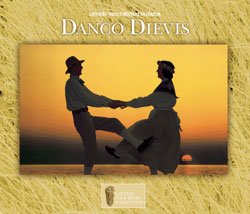
The newest addition to UPE Recording Co.‘s Latvian Folk Music Collection, Danco Dievis, can be seen as a continuation of last year’s Latviešu danči (Latvian Dances). Musically I found both albums to be just as enjoyable, but in terms of liner notes Danco Dievis is superior.
In this collection all of the pieces are not played by the same group as they were in Latviešu danči. Here they are performed by four different groups: Dziga, Laimas muzykanti, Dandari and Danču mūzikas grupa. Danču mūzikas grupa is composed of individuals who belong to other groups. They include several musicians and singers (Ilga Reizniece, Kristīne Karele, Mikus Čavarts, Gints Sola, Andris Alviķis, Ilmārs Mežs and Māris Muktupāvels) who performed on Latviešu danči.
The author of the dance instructions is Ernests Spičs, who calls himself an ethochoreologist. I found many of these dances (such as “Suseklis” and “Tymsa, tymsa”) to be somewhat simpler than those on Latviešu danči. Maybe therefore some of these dance instructions seem to be clearer.
The collection contains many pieces that are not well known in North America. One, “Trīnīte,” is even from the Latvian village Lejas Bulāna in Siberia! Several others I heard for the first time.
The first song in the collection is a wonderful version of “Pērkonītis,” a well-known and much-loved dance. In this recording the verses are sung a cappella with just a drum providing a beat. Between the verses the music was purely instrumental. If you hear this piece in the morning, you will be singing and humming it all day long. The name of the album comes from the words of this song: “Danco Dievis ar Pērkonu,” translated as “God dances with Thunder.”
Another piece that will be familiar to many is “Krustdeja,” which may be better known as “Rucavietis,” a dance often learned and performed by Latvian folk dance ensembles in North America. Although listeners may not know it as a dance, the song “Samniekdēli” also will probably be recognized.
Of the lesser-known pieces on the album, the ones I enjoyed most were the toe-tapper “Suseklis” and “Vēžu dancis,” which had me feeling like I really was at a Saturday night dance somewhere in the Latvian countryside.
In addition to the dance instructions, the liner notes contain a short essay (in Latvian and English) about dancing. Spičs writes, “Dance is hardly comprehensible to the rational mind—there is no adequate intellectual explanation for it. Dance can only be comprehended by the senses. Dance offers the opportunity to find harmony with all that is: to find connections and to come into attunement with everyone and everything.” Anyone who has let themselves be swept away by a good polka will agree. Spics also comments that, although the liner notes include dance instructions, “one really should participate in events with traditional dancing in order best to learn how to create dance variations and even to improvise.” Unfortunately, for those of us outside Latvia, this may prove difficult.
Another nice aspect about the liner notes are the one or two sentences that tell a little about what region of Latvia the dance is from and what it’s like. For example, regarding “Tymsa, tymsa tei egleite,” Spičs writes, “Senā latgaliešu precību rotaļa, kas piemērota arī kautrīgiem mūsdienu jauniešiem” (“Old wedding game from Latgale; also appropriate for today’s shy youth”).
Overall this is another worthy addition to the Latvian Folk Music Collection and to the collection of any individual who enjoys Latvian folk music.
(Editor’s note: This article originally appeared on SVEIKS.com.)
Details
Danco Dievis
Latviešu tautas mūzikas kolekcija
UPE Recording Co., 2000
UPE CD 019
© 1995-2024 Latvians Online
Please contact us for editorial queries, or for permission to republish material. Disclaimer: The content of Web sites to which Latvians Online provides links does not necessarily reflect the opinion of Latvians Online, its staff or its sponsors.





Paldies, jums, Daina par šo apskatu. Tikai tagad to atradu. Izlasīju ar lielu interesi. Vai jūs esat rakstījusi par trad. dejas lietām? Tagad strādāju pie Polkas izpētes. Mēģinu noskaidrot, vai latviešu jaunatne to dejo arī sadzīvē utt. vēlreiz paldies!